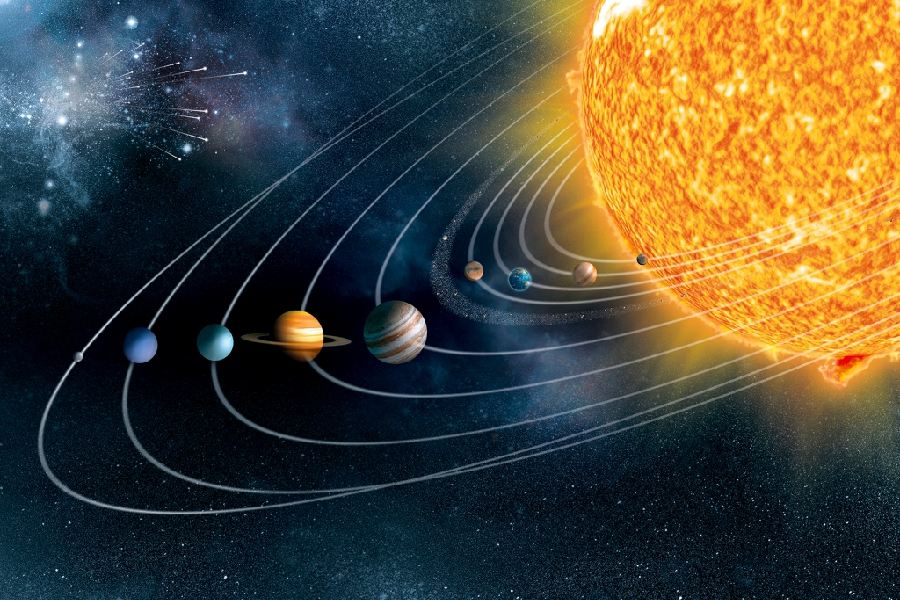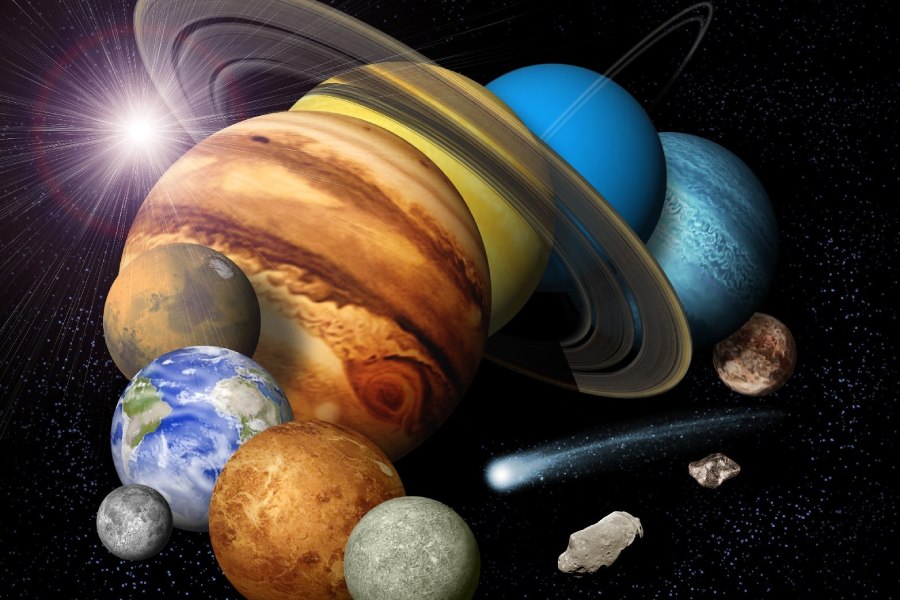Looking at the ground below us, we rarely appreciate how Earth’s sturdy structure and deep iron core uniquely enable thriving surface life. By quantifying density profiles that compare planets, Earth’s makeup stands apart. But what is the density of terrestrial planets? Why are terrestrial planets denser than Jovian planets?
Understanding density relationships across inner neighboring planets like Mercury, Venus, and Mars unveils insights into formative histories and internal compositions. In this exploration, we delve into the heart of these planets, unveiling the enigma of their average density.
Join us on a journey to understand the fundamental characteristics that define these rocky worlds and how their densities play a crucial role in shaping their essence.

Density of Terrestrial Planets
Terrestrial planets exhibit varying densities, distinguished by their solid surfaces and rocky compositions. They are influenced by factors such as metal content and planetary size. But which planet has the highest density?
Earth, with an average density of about 5.5 g/cm³, features a substantial iron and nickel core contributing to its density. In contrast, Mercury, the smallest terrestrial planet, boasts a higher density of approximately 5.3 g/cm³ due to its proportionately large iron core.
The variations in density among terrestrial planets underscore the diverse geological processes and compositional differences that shape their internal structures. These differences highlight the complexity and individuality of each rocky world in our solar system.
Comparative Analysis of Terrestrial Planets
Terrestrial planets refer to the rocky planets in the inner Solar System closest to the Sun. They include Mercury, Venus, Earth, and Mars.
Unlike gas giants like Jupiter, these four planets have a solid surface. They have some similarities but key differences that impact their densities and other features.
Identifying the terrestrial planets
Mass refers to the amount of matter in a planet and is typically measured in kilograms or multiples of Earth’s mass. On the other hand, volume represents the three-dimensional space a planet occupies and is measured in cubic units like cubic kilometers.
Density, a crucial factor, is determined by dividing the mass of a planet by its volume. This relationship relies on the planet’s composition and physical structure, such as the presence of an iron core. In essence, density provides insights into how materials are distributed within a planet.
Mercury
Mercury, the smallest terrestrial planet, holds just 5.5% of Earth’s mass and 5.6% of its volume. To put it in perspective, Mercury could easily fit within the continental United States. Despite its petite size, Mercury boasts an unusually high density, measuring 5.3 g/cm3.
This heightened density points to Mercury’s substantial iron content, suggesting the presence of a solid iron core that dominates much of the planet’s interior. This extensive metallic core significantly elevates Mercury’s overall density compared to the rest of the terrestrial planets, highlighting its iron-rich composition.
Venus
Venus, often referred to as Earth’s twin, closely resembles our planet in terms of size and density. It possesses approximately 82% of Earth’s mass and 86% of its volume, maintaining a similar density of 5.2 g/cm3. However, what sets Venus apart is its notably thick carbon dioxide atmosphere, contributing to an extreme surface pressure.
Among the terrestrial planets, Venus stands out due to its dense and heat-trapping atmosphere. The atmospheric pressure on Venus exceeds 90 times that of Earth, creating a powerful greenhouse effect. As a result, Venus claims the title of the hottest planet in our Solar System.
Earth
As the benchmark in comparative planetology, Earth boasts one Earth mass, one Earth volume, and a 5.5 g/cm3 density. This showcases its intricate internal makeup with an iron core, a dense silicate mantle, and distinct continental and oceanic crusts.
Among the terrestrial planets, Earth stands alone with its surface water and dynamic plate tectonics, which play a vital role in shaping our planet’s distinctive crust structure. These factors contribute significantly to Earth’s hospitable environment for life.
Mars
Mars, about 11% of Earth’s mass and 15% of its volume, is smaller. Despite a core of iron and nickel, its average density is only 3.9 g/cm3, lower than Earth’s. Mars lost much of its atmosphere over time, leading to the disappearance of liquid water and the presence of water ice near the surface.
Despite having the solar system’s largest volcanoes, Mars is less dense overall due to its low-density mantle and crust composition compared to Earth and Venus. Mars appears to have a relatively large iron core size in relation to the entire planet.

Density of Terrestrial Planets vs Jovian
Are terrestrial planets more dense? The four inner or terrestrial planets are denser than the four gas/ice giants or Jovian planets orbiting farther out in the Solar System.
The terrestrial planets have an average density of 5 g/cm3 compared to only 1.3 g/cm3 for the Jovian planets. This huge difference in density reflects their contrasting compositions and internal structures.
Structure and composition
The terrestrial planets, including Earth, have mantles and crusts made of metallic and silicate rocks that encase a dense metal core. Gravity compresses their solid surfaces and interiors, leading to high density.
On the contrary, gas giants like Jupiter are primarily composed of lighter gases such as hydrogen and helium. They may have a small rocky core hidden beneath their surface clouds.
Comparison of densities
As mentioned, the terrestrial planets, including Earth, Mars, Venus, and Mercury, boast densities ranging from almost 4 to over 5 g/cm3. In contrast, gas giants such as Saturn and Jupiter exhibit very low densities, measuring under 2 g/cm3 due to their lack of metals and rocks. Uranus and Neptune, both ice giants, have densities around 1.3 g/cm3, which is close to that of liquid water.
Unlike the Jovian planets with weaker gravity, the terrestrial planets retained dense gases like nitrogen, oxygen, and carbon dioxide. The stronger gravity of these rocky planets compressed and differentiated their interiors, resulting in higher densities as heavier materials sank closer to their cores.
Factors Influencing Terrestrial Planet Density
Composition of planetary materials
The composition of metals, rocks, and gases on a terrestrial planet directly impacts its density. The overall density decreases when there’s an increase in metals such as iron and a decrease in silicates. Conversely, a higher proportion of metals than rocks increases the planet’s density.
Mercury is the densest terrestrial planet due to its elevated iron content relative to silicates and other compounds. A planet’s density is influenced by heavier elements with higher atomic weights, such as radioactive uranium and thorium, which contribute to internal heat.
It also correlates with the size of its metallic core, particularly one rich in iron, along with traces of nickel and other elements. This is evident in Mercury, where the larger metallic core contributes to its heightened density.
Over time, the average density of a planet increases as heavier materials sink and concentrate, altering the composition from its initial state. The melting process aids in the differentiation of layers based on density, resulting in a stratified structure.
Relationship between core characteristics and overall density
As evident from Mercury, larger metallic cores increase overall planetary density substantially. Core composition mixtures also factor, such as solid vs liquid state. Differentiation to generate dense metal cores with lighter silicate mantles causes terrestrial planets to have higher net densities than their original starting materials.
Impact of atmosphere and surface conditions
Unlike Mercury and Mars, Venus experienced a significant increase in surface atmospheric density due to the greenhouse effect. However, this doesn’t significantly impact the overall planetary density.
Features like oceans, glaciers, mountains, and landforms contribute to density variations, but they comprise only a small portion of the total planetary mass and volume. As a result, the effects of their density get averaged out in the larger context.
Density and Planetary Evolution
Density in planetary formation and processes
A planet’s density depends on how it was formed. Factors such as its place in the solar nebula and its distance from the Sun play a big role. Also, how quickly it accumulated matters a lot. These factors influenced the composition and density of terrestrial planets.
Planets that formed closer to the Sun were hotter and denser. During accretion, small planetesimals made of metals, silicates, and gases came together because of gravity. The impact melted materials when they collided, causing heavier iron to sink towards the planet’s center. This process created cores on the planets.
The role of early conditions in determining density
Initial temperature differences determined the fate of materials, dictating whether they would condense or remain in a gaseous state. In the hotter regions closer to the sun, only metals, silicates, and rocks had the conditions to form the building blocks of future terrestrial planets.
Meanwhile, the cooler outer regions of the solar system witnessed the accumulation of ice and abundant hydrogen/helium gases. It results in lower densities for the Jovian planets.
The specific nature, sequence, and duration of collisions and coalescence among planetesimals were crucial in shaping planets’ final density and internal structure. Radioactive elements contributed to sustaining the heat within inner planets, leading to partial melting and differentiation of their structures.
As planets evolved, early dense atmospheres, except Venus, were gradually lost to space for most terrestrial worlds. This atmospheric transformation shaped the distinct characteristics of terrestrial planets over time, with Venus standing as a notable exception in retaining its initial dense atmosphere.
Conclusion
We covered the density of terrestrial planets in our Solar System and the factors impacting why Mercury, Venus, Earth and Mars show significant yet differing densities.
We explored various factors, including core composition, interior structure, surface conditions, and atmospheric evolution. These elements collectively influence the density of planets throughout their history, shaping their unique properties. Earth, in particular, stands out as the only planet with oceans and life.
Our focus was to emphasize the similarities and differences among our terrestrial neighbors, such as Venus. Despite sharing a comparable volume, Venus deviates in rock composition, leading to significant variations in gravity and density. We believe that understanding the reasons behind these density differences among terrestrial planets will inspire and drive further exploration across the cosmos.
